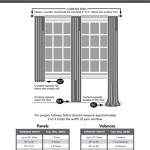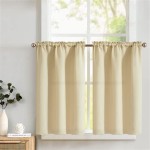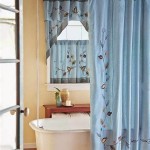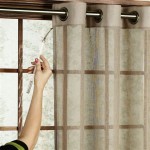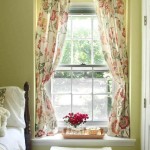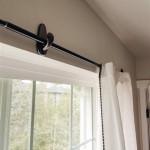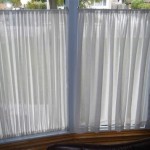Thermal Curtains for French Doors: Enhancing Energy Efficiency and Comfort
French doors offer an undeniable aesthetic appeal, allowing ample natural light to flood into interior spaces and providing seamless access to outdoor areas. However, their large glazed surfaces can also contribute significantly to energy loss, impacting interior comfort and increasing utility bills. Thermal curtains designed specifically for French doors provide a practical and aesthetically pleasing solution to mitigate these issues. These curtains are engineered with specialized fabrics and construction techniques aimed at minimizing heat transfer, effectively regulating interior temperatures year-round.
The increasing demand for energy-efficient solutions has led to significant advancements in thermal curtain technology. These curtains are no longer limited to basic insulating properties; contemporary designs incorporate a wide range of colors, patterns, and textures, allowing homeowners to seamlessly integrate them into various interior design styles. Understanding the features and benefits of thermal curtains is crucial for making an informed decision when selecting the optimal solution for French doors.
Understanding Thermal Curtain Functionality
The core function of thermal curtains is to reduce heat transfer between the interior and exterior environments. This is achieved through a combination of fabric properties, construction techniques, and installation methods. Primarily, the effectiveness of thermal curtains relies on their ability to minimize three primary modes of heat transfer: conduction, convection, and radiation.
Conduction refers to the transfer of heat through direct contact. Thermal curtains utilize multiple layers of fabric, often incorporating an insulating core, to impede the flow of heat through the material itself. The thicker and denser the fabric, the more effective it is at reducing conductive heat transfer. Materials like fleece, flannel, and specialized thermal liners contribute to this insulating barrier. The number of layers also plays a crucial role. Multi-layered curtains create air pockets that further reduce heat transfer by acting as an additional barrier.
Convection involves the transfer of heat through the movement of fluids, in this case, air. Thermal curtains minimize convection by creating a barrier that prevents air from circulating freely near the window. When properly installed, the curtains should fit snugly against the door frame, preventing drafts and air leaks. Side returns, which wrap around the sides of the door frame, are particularly effective in sealing the edges and preventing convective heat loss or gain. The height and width of the curtains are important factors; they should extend beyond the door frame to minimize air circulation around the edges.
Radiation is the transfer of heat through electromagnetic waves. During summer, sunlight entering through French doors can significantly increase interior temperatures. Thermal curtains often incorporate a reflective backing, typically a light-colored or metallic coating, which reflects a portion of the incoming solar radiation back outside. This reduces the amount of heat absorbed by the interior space. In winter, the same reflective backing can help to retain heat inside the room by reflecting radiant heat back into the space. The effectiveness of the reflective backing depends on its reflectivity and coverage. Some curtains feature a full reflective backing, while others have a partial coating.
Key Features to Consider When Selecting Thermal Curtains
Choosing the right thermal curtains for French doors requires careful consideration of several key features. These considerations encompass the fabric type, construction quality, insulation properties, aesthetic appeal, and ease of maintenance.
Fabric type significantly impacts the thermal performance and aesthetic characteristics of the curtains. Common fabrics include polyester blends, cotton blends, and specialized thermal materials. Polyester blends are durable, wrinkle-resistant, and relatively inexpensive, making them a popular choice. Cotton blends offer a softer texture and are often more breathable, but may require more maintenance. Specialized thermal fabrics, such as those incorporating acrylic suede or flocked materials, offer superior insulation properties. The choice of fabric should align with the desired level of insulation, aesthetic preferences, and budget constraints.
Construction quality refers to the durability and craftsmanship of the curtains. Look for curtains with reinforced seams, sturdy grommets or rod pockets, and high-quality linings. The stitching should be even and consistent throughout the curtain. Reinforced seams prevent tearing and fraying, ensuring the curtains withstand regular use. Grommets or rod pockets should be securely attached and appropriately sized for the curtain rod. A high-quality lining provides additional insulation and protects the face fabric from fading. Inspecting the construction quality ensures longevity and optimal performance.
Insulation properties are paramount when selecting thermal curtains. Consider the R-value, which measures the curtain's resistance to heat flow. A higher R-value indicates better insulation. The number of layers, the type of insulating material, and the presence of a reflective backing all contribute to the overall insulation performance. Some curtains are specifically labeled as "blackout" curtains, indicating their ability to block out virtually all light. While blackout curtains are excellent for insulation, they may not be suitable for all applications, as they can create a very dark environment. Carefully assess the desired level of insulation and light control when making a selection.
Aesthetic appeal is an important consideration, as the curtains should complement the existing décor and enhance the overall look of the room. Thermal curtains are available in a wide range of colors, patterns, and textures. Choose curtains that match the color scheme and design style of the room. Plain, neutral-colored curtains are versatile and can easily blend with various décor styles. Patterned curtains can add visual interest and personality to the space. Consider the texture of the fabric, as it can affect the overall ambiance of the room. Smooth fabrics create a more modern look, while textured fabrics add warmth and depth.
Ease of maintenance is another practical consideration. Choose curtains that are easy to clean and maintain. Many thermal curtains are machine washable, while others require dry cleaning. Check the care instructions before purchasing. Consider the fabric's resistance to wrinkles and fading. Wrinkle-resistant fabrics are easier to maintain and will look neater over time. Fabrics that are resistant to fading will retain their color and appearance for longer. Regular cleaning and maintenance will help to prolong the life of the curtains and ensure optimal performance. Vacuum the curtains regularly to remove dust and dirt. Follow the care instructions carefully when washing or dry cleaning the curtains.
Optimizing Thermal Curtain Installation for French Doors
Proper installation is crucial for maximizing the thermal performance of curtains on French doors. Inadequate installation can negate the benefits of even the highest-quality curtains. Several factors influence the effectiveness of the installation, including the choice of curtain rod, the hanging height, and the use of accessories to seal gaps.
The choice of curtain rod significantly impacts the insulation effectiveness. Opt for a rod that is sturdy enough to support the weight of the curtains and extends beyond the door frame on both sides. This allows the curtains to fully cover the door and minimize air leakage. Return rods, which curve back toward the wall, are particularly effective in sealing the edges of the curtains and preventing drafts. The diameter of the rod should be appropriate for the grommets or rod pockets of the curtains. A rod that is too thin may not provide sufficient support, while a rod that is too thick may make it difficult to slide the curtains open and closed.
Hanging height influences the amount of air leakage at the top and bottom of the curtains. Hang the curtains as close to the ceiling as possible to minimize heat loss through the upper gap. The curtains should extend slightly beyond the floor to seal the bottom gap and prevent drafts. Consider using adjustable curtain rods or custom-made curtains to achieve the perfect hanging height. Ensure that the curtains are properly weighted at the bottom to prevent them from billowing and creating gaps. Weights can be sewn into the hem of the curtains to improve their drape and seal.
Accessories can further enhance the thermal performance of the curtains. Side returns, which wrap around the sides of the door frame, are essential for sealing the edges of the curtains and preventing drafts. Magnetic tape or Velcro strips can be used to attach the curtains to the door frame, creating a tighter seal. Draft stoppers placed along the bottom of the doors can further minimize air leakage. Caulk or weather stripping can be used to seal any gaps around the door frame. Investing in these accessories can significantly improve the insulation effectiveness of the curtains.
Regular maintenance of the installation is also important. Check the curtain rod and accessories periodically to ensure they are in good condition. Tighten any loose screws or bolts. Replace worn-out weather stripping or caulk. Clean the curtains regularly to remove dust and dirt. Proper maintenance will help to prolong the life of the curtains and ensure optimal thermal performance.
By understanding the functionality, key features, and installation considerations of thermal curtains, homeowners can effectively enhance the energy efficiency and comfort of their spaces with French doors. This careful selection and implementation result in tangible benefits, including reduced energy consumption and a more pleasant living environment.

Lapalife Blackout Door Curtain Thermal Insulated French Curtains For Privacy Tie Up Shades Tricia Blind 1 Panel 26 X 66 Black

2 Panel French Door Curtains With Rod Pocket Tieback Indoor Sun Blocking Grommet Thermal Blackout Curtain For Window Kitchen Patio Doors 25 X

Black French Door Curtains Privacy Thermal Insulation Soundproofing Blackout Doorway Window Treatments Drapes For Glass Patio Etsy

2 Panel French Door Curtains With Rod Pocket Tieback Indoor Sun Blocking Grommet Thermal Blackout Curtain For Window Kitchen Patio Doors 25 X

French Door Curtains Rod Pocket Thermal Blackout Curtain For Doors With Glass

Getuscart Aquazolax Solid Blackout Thermal Curtains French Door Panels 54 W X 72 L Red

Miulee Sidelight French Door Blackout Curtain Thermal Insulated Drapes Light Blocking 1 Panel Greyish White W25xl72

Blackout French Door Curtain Privacy Thermal Insulated Window For Glass Front Sliding Patio 1 Panel

Miulee Sidelight French Door Blackout Curtain Thermal Insulated Drapes Light Blocking 1 Panel Greyish White W25xl72

Getuscart Ryb Home Room Darkenign Curtains For French Doors Privacy Door Window Thermal Insulate Covering Patio Glass Front 26 Inch X 80 Inches Stone Blue 1 Panel

